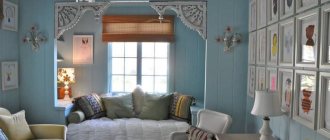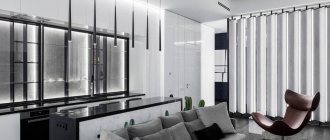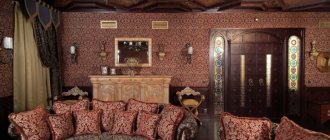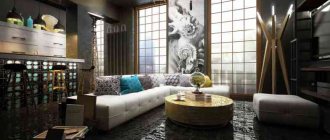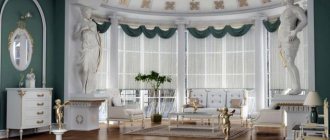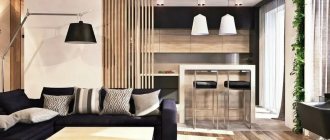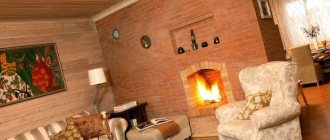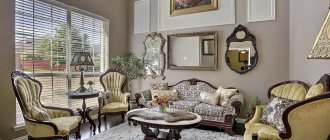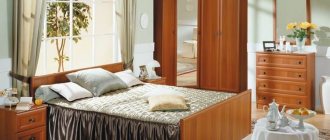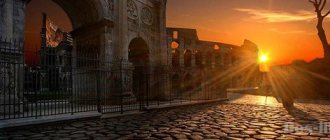2018-09-18
Author: Belfan
From this article you will learn:
- How the Italian style in the interior was born
- What are its characteristic features
- What varieties are there?
- Characteristic features of modern Italian style in the interior
- How to decorate the interior of different rooms in Italian style
- What finishing materials form it
- What furniture is suitable for an Italian-style interior
- What should textiles be like in the interior?
Interior design in Italian style belongs to the Mediterranean category and is expressed in a combination of baroque and free country. From the perspective of climatic diversity, this style is divided into types and is effectively used by designers when decorating houses and city apartments.
Distinctive features of Italian style in the interior
Italian interior differs from others in several attributes:
- careless eclecticism combines pompous luxury with rustic simplicity, and each designer is free to determine for himself which direction he likes best;
- natural materials in the decoration create a pleasant, natural atmosphere of warmth;
- The style is characterized by large windows that let in maximum light and light tulle curtains that do not prevent it from flowing in;
- the abundance of fresh flowers creates the feeling of a summer garden;
- a room (even a large one) is usually combined into one and zoned using arches and furniture - in an apartment you can include a balcony in the room by making an arch in the wall that separates it;
- curtains made of bright beads or light fabrics are hung in the arches, and sometimes they are left completely open.
The main colors of the Italian style are warm shades of beige, delicate blue, dark green and purple, and natural wood. Bright accents are not welcome.
The main distinguishing characteristic is the maximalism of the solutions and the general feeling of a sunny afternoon somewhere in the Mediterranean, even on a stormy February evening.
Botany and ecology
The eco-friendly trend will last a long time because it develops in parallel with technology. Over the past 10 years, production has been gradually replaced by more environmentally friendly ones. For example, chrome plating and other galvanic coatings are, if possible, replaced by painting, since now paint and varnish materials are similar in properties, but cause less harm during the production process. The same applies to all kinds of slab materials: they are becoming easier to manufacture, and the quality is approaching natural ones or surpassing them in some respects.
There was not a single stand at the exhibition that did not contain living plants, from succulents to munsteras and palm trees.
Lead designer Yulia Kharitonova.
Varieties of style and color palette
Colors vary depending on the style: they can be warmer, cooler, brighter, or duller. Everything is determined by which variation is used.
Italian rustic style
Natural materials, a lot of wood and stone, no wallpaper and, of course, no plastic. There is a lot of light, but the colors are muted: bright accents in the rustic variety are especially inappropriate. Homemade decorative elements are a must: an embroidered napkin under a vase, carvings, wooden figurines, a hand-knitted rug on the floor.
If you are decorating a kitchen, then you need clay dishes that look as if the owners themselves sculpted them.
Italian Mediterranean style
Mediterranean style should be reminiscent of warmth, summer and the sea. High ceilings, a lot of light, the decoration is not wood, but stone and plaster. Warm colors that are uncharacteristic of the style are a must: yellow, soft green with a yellow bias. Be sure to have arched openings covered with jingling beads, frescoes and mosaic decoration, which looks especially good in the bathroom (the bathtub itself should be the size of a small swimming pool).
Italian classic style
All the same arches and high ceilings, but the colors are often light, without bright accents, and ostentatious luxury is also added: stucco molding, mirrors in heavy frames, classical paintings, bulky furniture, metal chandeliers with crystal elements. Preferably sculptures, figurines and porcelain to complete the picture.
The main thing is not to overload and not make the classic Italian style too bulky, and the room too crowded and cramped.
Italian Tuscan style
Tuscany is a province in Italy, and Tuscan style blends French, Italian and Spanish influences. The colors remain natural, but become more vibrant. Plaster is placed on the walls, tiles or marble are placed on the floor.
The furniture is lush, not too bulky, with metal elements. Be sure to have fresh flowers and a landscape with a vineyard on the wall.
Modern Italian style
The design of an apartment in a modern Italian style allows you to replace traditional materials with more modern ones. You can put laminate on the floor, not parquet. Place wallpaper on the walls rather than covering them with tiles or plaster. Ceilings can be made suspended (especially if a fabric version is used).
And of course - a lot of light, a lot of space (almost like in a loft), a lot of natural colors, and always trinkets that refer to Italy in different historical periods.
Surface finishing in Mediterranean style apartments/houses
- Walls
. The color scheme is yellow and gold, brown and beige tones. Wall finishing materials - liquid wallpaper, paintable wallpaper, regular wallpaper in one tone, soft plaster. Additional finishing elements can include stone and wood panels. Such surfaces can also be varnished. - Floor
. Floor materials - marble with a characteristic sheen, wood in the form of laminate, parquet, boards. A good and almost obligatory technique is to create the effect of aging and abrasion. - Ceiling
. Integral elements are plaster, the presence of beams, uneven texture “like clay” or the absence of moldings. Italian interiors are especially good with high ceilings. Their external simplicity is diluted by pendant chandeliers with intricate wooden frames or interesting forged elements.
Room layout
Italian style in the interior of an apartment can be divided into two directions: classic and modern. Classics are most often called traditional Italian styles, without dividing them into Tuscan, rustic, Mediterranean and directly classic. They look great in cottages with high windows and spacious rooms. Columns and arched openings will be an integral part of the interior.
High ceilings are decorated with beams, and the obligatory asymmetry of the room is created with the help of colonnades and niches. Don't forget to prepare a place for a full fireplace.
A modern Italian-style apartment can be quite modest in size; the main emphasis is on decor and interior content. However, if you have a balcony or windows with French glazing to the floor, they can be used for maximum immersion in this direction.
A modern Italian interior will be a real find for owners of premises with complex geometry.
Everything that seemed to you as a disadvantage of the layout: the absence of a full-fledged corridor, an asymmetrical niche in the wall, a doorway that you want to move a few tens of centimeters - Italian design will turn these disadvantages into advantages.
Colors
Preference is given to soft pastel shades that can bring lightness, freshness and visually enlarge the space. This approach allows you to create a winning background that does not distract attention from the impressively decorated set and other accessories that form the main concept of the room. Beige or graphite shades will be among the current solutions. An accentuated option for accessories, emphasizing your temperament and inner expression, will be colors such as:
1. Green;
2. Red;
3. Blue;
4. Orange.
Italian style in the interior: past and present
The modern version of the Italian style has its predecessor. It is to him that the design we are familiar with owes many of the basic characteristics that are so loved by a wide range of the public.
The basis for the Italian style was the design, which is called Tuscan. Its name was given by the province of Tuscany in the central part of Italy, and it arose thanks to objective historical and economic historical processes.
In the first half of the last century, Italy demonstrated an avalanche-like growth of cities and urban population. The villagers went to work, their habitats became empty. In the cities there was not enough housing or places to build it, and then the townspeople gradually began to populate the nearest suburbs, abandoned by their previous inhabitants.
This became possible with the development of railway and road communications.
City dwellers, recent villagers themselves, inhabited abandoned buildings, arranging them to their liking. Houses in Tuscany were traditionally built from stones and clay, often with patios and open terraces with arches supported by columns.
Most often, such buildings did not differ in ceiling height, but were spacious. The new residents provided the houses with strong shutters and oak doors so that other settlers would not want to redistribute the property. For the most part, the windows were low and relatively small, often raised higher to the ceiling.
This is how the famous Tuscan architecture developed, which is a cross between a fortified monastery and a typical Mediterranean house with the obligatory courtyard, arches and columns.
The distinctive features of the style were archaic simplicity and practicality, the use of natural materials, among which stone, clay and ceramics came first.
The natural Italian liveliness of mind and thirst for beauty helped to decorate such an interior with examples of painting in the spirit of the old masters, sculptural examples, and traditional Italian frescoes on wet or dry plaster.
The Tuscan style was distinguished by laconicism and even severity. Naturally, over the years it changed, softened, and became embellished. There are much more wooden objects and furniture in it, because the Italians are famous masters of furniture production.
The decoration was complemented by a variety of ceramic tiles, which became brighter and richer. Mosaics also appeared, including glass ones. It was complemented by stained glass, colored glass and glass products.
Modern Italian style has retained many basic features. In particular, architectural brevity and simplicity, in which the symmetry of ancient designs is clearly visible. The most popular architectural form for the Italian style is the arch.
Windows, doors, interior partitions, niches in the room, and simply decorative elements designed to decorate the space can be made in this form.
Simplicity and practicality are continued in the finishing method. For walls, textured plaster or paint is often chosen, which is easy to apply, looks good and can be quickly updated if necessary. You can choose a rustic, even rough surface, or make the wall perfectly smooth. Plaster and paint are preferably matte, absorbing light.
Ceramic tiles are actively involved in the Italian style.
It can lie on the floor in the form of ancient stone slabs, decorate the lower third of the wall, or rise in columns in the corners of the room. Unlike our traditions, Italians also use tiles in residential areas, without limiting their distribution to the kitchen and bathroom.
Often, tiles are chosen with an intricate oriental pattern, similar to Arabic script. The influence of the Moorish style is felt here, but you can’t erase the words from the song, especially since the styles of the Mediterranean basin are related and often demonstrate similar borrowings.
In the Tuscan style, the influence of antiquity was not too noticeable; rather, peasant thoroughness and practicality played the first fiddle. However, subsequently, in the second half of the 20th century, elements reminiscent of the glorious past of the Apennines began to be more actively introduced into the Italian style.
In the modern version of the Italian style, you can see many features that refer us to ancient examples.
This includes the symmetry of the design of the space, and additional decoration of columns in the form of antique porticoes and pilasters, and stucco decorations, and sculptural elements. The interior layout itself began to gravitate toward antiquity, with clear centering. Although for a Tuscan interior, the presence of a clearly defined center was precisely an optional feature.
Lovers of Italian design can choose the mood they want to bring into the interior.
By choosing a more practical, solid and rough style, gravitating towards the original Tuscan interior, you can get a cozy, albeit somewhat brutal, image. It will promote environmental cleanliness and remove everything superficial and excessive from the environment, and will also give a feeling of comfort and security to every inhabitant of the house.
By adding more sophistication in the form of intricate patterns, whimsical furniture made of natural wood - of course, Italian production - a few antique paintings in old frames, you can get a solid and respectable style with a clear hint of aristocracy.
Modern trends of minimalism and constructivism can also be superimposed on traditional Italian basic principles.
The result will be a restrained, but nevertheless expressive interior with an emphasis on natural materials and functional furniture, with original arched design of open doorways and ceramic decors.
Subtleties of selection of finishing materials
In an Italian interior, the quality of the room’s finishing plays an important role. When choosing finishing materials, the following criteria must be taken into account:
- Environmentally friendly. Residents of sunny Italy value nature and are wary of anything that could be harmful to health. Enormous harm can come even from the paint used to decorate the walls in the room. All building materials purchased for the home must be environmentally friendly.
- Naturalness. When choosing such an interior solution, you need to be prepared for high costs. This interior solution is characterized by a natural finish. Wood, expensive marble, high-quality plaster, and natural stone are used.
- Purpose of the room. The choice of finish should be based on the characteristics of a particular room. The bathroom has high humidity. It can only be covered with water-resistant materials. In a nursery, a comfortable climate plays a huge role. The baby should not run on the cold floor. The floor finish should be selected based on this requirement.
- Performance. Finishing materials must be strong, resistant to mechanical damage and household cleaning products. High performance properties will allow you to enjoy a consistently beautiful environment in your apartment for many years in a row.
- Fire safety. Many natural facing materials are flammable. For example, an abundance of wood trim can lead to tragic consequences. All wood must be treated with a special impregnation. A more serious approach to the installation of the electrical network will help protect your home from fire. This issue should only be dealt with by a professional.
- Compatibility with each other. The cladding of the floor, walls, and ceiling should be in harmony.
Interior basics
Residents of southern Europe are very sensitive to the heritage of their homeland. Even the oldest traditions are observed impeccably. Despite technological progress, furnishings based on tradition are still used in design. In the southern European style, hand-made furniture, expensive Venetian plaster, frescoes, and stucco are used. These are the basic principles of direction.
Spacious rooms with large windows are best suited for the Italian style.
This can be either a house outside the city or an ordinary city apartment.
The most important requirement for furnishings is environmental friendliness. It is allowed to choose only safe, natural materials - natural motifs create a special coziness in the living space. You can see echoes of country music in this. However, unlike country music, various small details will be present in the setting. In the homes of real Italians you can see various lamps, clocks, extraordinary dishes, photo frames, paintings. These little things do not just decorate an apartment or a private house.
Each of the items has its own unusual story, which the owners are happy to tell their guests about. Decorative items and souvenirs are constantly increasing in quantity. Thanks to this, the design of the room is never monotonous.
An unusually shaped floor lamp attracts attention
See also: Stucco molding in the interior
Curtains are an integral part of the decor
It is difficult to imagine authentic Italian style in the interior without luxurious Italian curtains. Their first appearance dates back to the eighteenth century. Such curtains were previously used in the designs of castles and palaces. They were the embodiment of aristocracy and sophistication. Today, you also cannot do without them when decorating the design of an apartment, cottage, or dacha.
Real curtains from Italy have several distinctive features:
- The curtain rods secure the top of the curtains firmly. The curtains are opened by gathering them diagonally, followed by fixing them with a cord. The material can be dissolved and collected as desired.
- Curtains for wide windows are not made in one piece. They do not connect in the middle; they only cover the corners of the window opening. This option is perfect for the living room.
- Many curtain models are multi-layered. The canvases simply overlap each other. To preserve the design, translucent fabric is used to make canvases.
- Curtains for the kitchen are usually rolled. They are convenient to use, easy to clean, and transmit the required amount of sunlight. Roller blinds can be decorated with beautiful patterns and ornaments.
- Curtains made in Italy are expensive. Don't look for a cheap alternative. This product is a fake. It will quickly lose its appearance.
Italian pop art
Since the 1950s, pop art has become very popular in Italy. A design direction aimed primarily at young people and spread thanks to the American consumption model. At that time, plastic and objects made from it became very popular.
Pop art has become widespread in Italian graphic design and is the epitome of radical design. Pop art has the following features:
- Bright colors
- Cartoon images, flat design
- Dynamic composition
- Using collage techniques
- Optical illusions in graphics
- Using images of stars and politicians
Pop art quickly found its application in logos, corporate identity, and advertising posters.
Apartment interior in different rooms
In addition to the characteristics of the style varieties, the purpose of the room also influences the decor. The hall, corridor, kitchen and bedroom require a different approach to design.
Kitchen
This is exactly the room where the decor looks especially good. Tile or natural stone is laid on the floor. The walls are covered partly with mosaic tiles (usually in the kitchen apron area) and partly with plaster. The ceiling is whitewashed, optionally leaving beams on it. An Italian-style kitchen is usually bright: the lighting should be plentiful, the chairs around the table should match the style, the curtains should be light and allow light to pass through well.
Accessories include a vase of flowers on the table, intricate sconces in the work area, earthenware or porcelain dishes, a painting on the wall.
Living room
There is also room to spread out in the living room. It can be finished with stone, but usually wood is preferred. Parquet is placed on the floor, beautiful wallpaper or plaster is placed on the walls. There is a lot of light in the room, paintings, milky, delicate shades in the design. Be sure to have a small sofa, comfortable armchairs, a floor lamp, and if the budget allows, then a fireplace and antique decoration.
Even in the rustic variety, a little luxury is permissible, while classic presupposes its obligatory presence.
The overall impression is beautiful, cozy, pleasant to live and no less pleasant to visit here.
Bedroom
Dark, deep colors are in demand in the bedroom - blue, dark green, olive. They calm you down and put you in a sleepy mood. Be sure to have a large bed, a pile of pillows in the bed, a closet - a large built-in one (in the modern version), with carvings on the doors (in the classic version) or roughly put together, with a simple design (in the country version).
It is better to cover the doorway not with a classic light curtain, but with a heavy curtain that will muffle the sounds of the rest of the house.
Children's
In the nursery, you can decorate the room a little more freely than in other rooms. Colored mosaics, paintings, and drawings on the walls are acceptable here. Of course, calm shades should predominate, but the nursery allows you to include bright accents. In the end, the room should not look strict, but, on the contrary, fun and interesting.
Bathroom
The room is predominantly tiled. It is appropriate to style it like a Neapolitan bathroom, with frescoes on the walls, small mosaics on the floor, with an abundance of small lamps and cute accessories.
Everything should fit into the color scheme and create a feeling of purity and light. Even a soap dish should look stylish and fit into the interior design concept.
When the renovation is completed, taking photos in such a bathroom will be a pleasure.
Hallway
The hallway also fits into the overall project: abundant light (preferably natural, but if there is no window, then an overhead one is also possible), a simple layout, a furniture trio - a wardrobe for outerwear, a shoe stand and a small chair for putting on shoes.
A mirror is a must, the frame of which must match the style variation.
Signs of a classic, modern interior
The concept of this style is divided into two directions. It can be classic or modern. What are their main differences?
The classic direction speaks of the desire of the owners of the house to revive the old days
Modern Italian style is an art space filled with non-trivial furnishings in the spirit of fashion
The signs of both directions are discussed in more detail in the table:
| Signs | Classic direction | Modern direction |
| Finishing | It is impossible to embody the classic Italian style in the interior without the use of expensive, natural materials. It is customary to use gypsum and ceramics for walls, and marble and parquet boards for floors. The ceiling is usually decorated with wooden beams. The finishing should be devoid of expressive decor. It is better to choose finishing materials in light colors. They should be as close to the natural appearance as possible. | Not everyone likes the luxury and pretentiousness of the classics. A simpler “branch” of the Italian style is the modern direction. In this case, the room is decorated with practical materials. The walls are decorated with thick, washable wallpaper, decorative plaster, laminate and parquet are laid on the floor. The ceiling is decorated with a glossy tension structure. When choosing a finish, safety, environmental friendliness, and attractive design are also valued. |
| Design features of the room | The main feature of this direction is the special configuration of the room. Wide-format windows, columns, and high ceilings add luxury to the atmosphere. When arranging a private home, you should definitely think about building a real fireplace. It is better to place it in the kitchen. The fireplace should be decorated with natural stone and marble. These materials are not cheap. If the financial budget is limited, you can get by with special facing slabs that imitate the surface of natural stone. | In modern Italian style, a non-trivial approach is valued. Typically, this direction is chosen by designers to decorate a room with an irregular, unconventional shape. If the room has a standard rectangular shape, partitions must be erected in it and various built-in niches must be made. Instead of a real fireplace, apartments can have electric ones. Modern models of such fireplaces have a natural look. It is difficult to distinguish them from the real ones at first glance. |
| Decor | Classic interior design in Italian style is impossible without decent decor. Decorative elements should act as focal points. You can decorate your apartment with a rare mirror, a valuable panel, a gilded baguette, an engraving, or an expensive multi-tiered chandelier. | Cute, dear trinkets can decorate a room in this direction: photo frames, souvenirs brought from travel, vases, books, unusual kitchen utensils. The number of accessories is practically unlimited. Flowers in pots can serve as interior decor. |
| Furniture | Suitable furniture cannot be found in a regular furniture store. A sign of a classic is the rarity and exclusivity of the item. It is better to make furniture to order using natural wood. | The trend in modern Italian style is furniture of unusual shapes and bright colors. It is necessary to place a large dining table in the dining area, and a metal bed in the bedroom. A distinctive feature of the kitchen will be a bar counter, the countertop of which will be made of stone. An unusual configuration should be the main criterion for choosing furniture. But we must not forget about practicality. Furniture must be of high quality and functional. |
Classic Italian living room
Modern bedroom in Italian style with a brick wall, deliberately decorated slightly casually
In modern interiors there are often combinations of Italian style with modernism
See alsoColonial style in the interior
Lighting
On the one hand, residents of southern countries are accustomed to bright natural light, on the other hand, this is why they are not drawn to lighting their homes too brightly, especially since there are no very long nights here. That is why the main chandelier, no matter how lush and huge it may seem, in an Italian-style room never gives off too much light, but shines softly and diffusely.
Of course, for certain needs, good lighting is still necessary, but this issue is solved by lamps that provide spot light.
Most often these are small wall sconces, leaving the center of the room in light twilight. According to the logic described above, the modern branch of the Italian style is very drawn to various stretch and suspended ceilings - they allow you to build in spotlights and not take up space near the wall.
How will the renovation work?
The work is carried out in several stages. Each service is negotiated at the cost estimate stage and recorded in the contract.
Basic stages of repair:
view album in new window
- Preparation, ordering of materials and control of their delivery.
- Installation of electrical , pipes and other communications.
- Rough and fine finishing.
- Complete furnishings.
- Cleaning and garbage removal.
view album in new window
Each room can receive an individual design - we will develop it taking into account all your wishes and carry out 3D visualization, which will help you evaluate the result before starting work.
Furniture
For aesthetically-oriented Italians, harsh chopped Nordic forms of furniture are something completely unacceptable. Southerners, on the contrary, love sophistication and smoothness in everything, which is why most furnishings contain light waves, curves and even patterns in their contours. If it is a table or a cabinet, then it should have small curved legs - it’s beautiful.
The inhabitants of Italy, by nature, are not accustomed to any harsh tests, so they look for comfort and convenience in everything. The predominant part of the furnishings fits the concept of upholstered furniture here - these are numerous sofas, armchairs and poufs.
Even the chairs at the dining table here should be soft and always have a high back - this is a matter of comfort.
Upholstered furniture upholstered in fabric, as well as bedroom sets, largely determine the color scheme of the room. We have already talked about what colors are welcome in Italian style, and textiles are selected according to the logic to be a bright accent against the background of the overall range.
Italians do not accept boring dullness, it puts pressure on them, and this rule is relevant not only in the nursery, but even in the usually strict (in our understanding) corridor.
Who will supervise the work?
Experience allows us to ensure maximum compliance of the project with the final result. The repair process is controlled by foremen and engineers. When ordering designer supervision services, control is also carried out by the designer.
view album in new window
Accessories and decor
It is not for nothing that Italy is considered a country with a very developed art, but all the great creations of recognized masters of painting and sculpture initially stood in the houses of wealthy Venetians, Genoese, and Florentines. Even if simpler citizens could not afford a real masterpiece, do not forget that the masters had ten times as many students, who also left a lot of heritage - in a word, one cannot do without paintings and figurines.
In addition, the Italian city-states actively traded with the entire Mediterranean, and therefore their inhabitants could boast of beautiful imported porcelain.
My apartment is outside the Moscow Ring Road. Can I order your services?
view album in new window
The regions where our company operates are Moscow and the Moscow region. You can order both an individual design project and a turnkey renovation.
view album in new window
